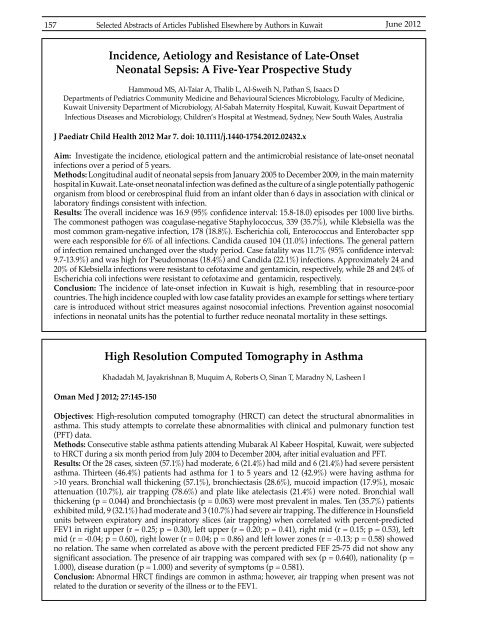Vol 44 # 2 June 2012 - Kma.org.kw
Vol 44 # 2 June 2012 - Kma.org.kw
Vol 44 # 2 June 2012 - Kma.org.kw
You also want an ePaper? Increase the reach of your titles
YUMPU automatically turns print PDFs into web optimized ePapers that Google loves.
157<br />
Selected Abstracts of Articles Published Elsewhere by Authors in Kuwait <strong>June</strong> <strong>2012</strong><br />
Incidence, Aetiology and Resistance of Late-Onset<br />
Neonatal Sepsis: A Five-Year Prospective Study<br />
Hammoud MS, Al-Taiar A, Thalib L, Al-Sweih N, Pathan S, Isaacs D<br />
Departments of Pediatrics Community Medicine and Behavioural Sciences Microbiology, Faculty of Medicine,<br />
Kuwait University Department of Microbiology, Al-Sabah Maternity Hospital, Kuwait, Kuwait Department of<br />
Infectious Diseases and Microbiology, Children’s Hospital at Westmead, Sydney, New South Wales, Australia<br />
J Paediatr Child Health <strong>2012</strong> Mar 7. doi: 10.1111/j.1<strong>44</strong>0-1754.<strong>2012</strong>.02432.x<br />
Aim: Investigate the incidence, etiological pattern and the antimicrobial resistance of late-onset neonatal<br />
infections over a period of 5 years.<br />
Methods: Longitudinal audit of neonatal sepsis from January 2005 to December 2009, in the main maternity<br />
hospital in Kuwait. Late-onset neonatal infection was defined as the culture of a single potentially pathogenic<br />
<strong>org</strong>anism from blood or cerebrospinal fluid from an infant older than 6 days in association with clinical or<br />
laboratory findings consistent with infection.<br />
Results: The overall incidence was 16.9 (95% confidence interval: 15.8-18.0) episodes per 1000 live births.<br />
The commonest pathogen was coagulase-negative Staphylococcus, 339 (35.7%), while Klebsiella was the<br />
most common gram-negative infection, 178 (18.8%). Escherichia coli, Enterococcus and Enterobacter spp<br />
were each responsible for 6% of all infections. Candida caused 104 (11.0%) infections. The general pattern<br />
of infection remained unchanged over the study period. Case fatality was 11.7% (95% confidence interval:<br />
9.7-13.9%) and was high for Pseudomonas (18.4%) and Candida (22.1%) infections. Approximately 24 and<br />
20% of Klebsiella infections were resistant to cefotaxime and gentamicin, respectively, while 28 and 24% of<br />
Escherichia coli infections were resistant to cefotaxime and gentamicin, respectively.<br />
Conclusion: The incidence of late-onset infection in Kuwait is high, resembling that in resource-poor<br />
countries. The high incidence coupled with low case fatality provides an example for settings where tertiary<br />
care is introduced without strict measures against nosocomial infections. Prevention against nosocomial<br />
infections in neonatal units has the potential to further reduce neonatal mortality in these settings.<br />
High Resolution Computed Tomography in Asthma<br />
Khadadah M, Jayakrishnan B, Muquim A, Roberts O, Sinan T, Maradny N, Lasheen I<br />
Oman Med J <strong>2012</strong>; 27:145-150<br />
Objectives: High-resolution computed tomography (HRCT) can detect the structural abnormalities in<br />
asthma. This study attempts to correlate these abnormalities with clinical and pulmonary function test<br />
(PFT) data.<br />
Methods: Consecutive stable asthma patients attending Mubarak Al Kabeer Hospital, Kuwait, were subjected<br />
to HRCT during a six month period from July 2004 to December 2004, after initial evaluation and PFT.<br />
Results: Of the 28 cases, sixteen (57.1%) had moderate, 6 (21.4%) had mild and 6 (21.4%) had severe persistent<br />
asthma. Thirteen (46.4%) patients had asthma for 1 to 5 years and 12 (42.9%) were having asthma for<br />
>10 years. Bronchial wall thickening (57.1%), bronchiectasis (28.6%), mucoid impaction (17.9%), mosaic<br />
attenuation (10.7%), air trapping (78.6%) and plate like atelectasis (21.4%) were noted. Bronchial wall<br />
thickening (p = 0.0<strong>44</strong>) and bronchiectasis (p = 0.063) were most prevalent in males. Ten (35.7%) patients<br />
exhibited mild, 9 (32.1%) had moderate and 3 (10.7%) had severe air trapping. The difference in Hounsfield<br />
units between expiratory and inspiratory slices (air trapping) when correlated with percent-predicted<br />
FEV1 in right upper (r = 0.25; p = 0.30), left upper (r = 0.20; p = 0.41), right mid (r = 0.15; p = 0.53), left<br />
mid (r = -0.04; p = 0.60), right lower (r = 0.04; p = 0.86) and left lower zones (r = -0.13; p = 0.58) showed<br />
no relation. The same when correlated as above with the percent predicted FEF 25-75 did not show any<br />
significant association. The presence of air trapping was compared with sex (p = 0.640), nationality (p =<br />
1.000), disease duration (p = 1.000) and severity of symptoms (p = 0.581).<br />
Conclusion: Abnormal HRCT findings are common in asthma; however, air trapping when present was not<br />
related to the duration or severity of the illness or to the FEV1.
















